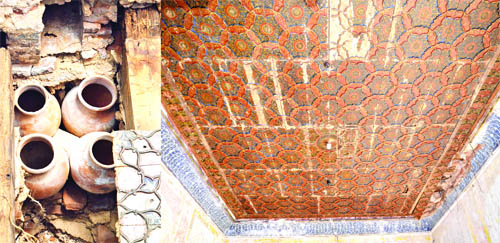Sunny Dua
Every time one visits Mubarak Mandi which once used to be the highest seat of power, mega yet crumbling structures located within the historic complex unfold layers of mysteries ranging from architecture to layout and from utilities to construction materials used in building this fortified monolithic block of palaces, offices, corridors, domes, protection walls and courtyards.
Though conservation work on some buildings is going on yet lack of priorities is sure to deprive state of a historic monument that could later be known as ‘Mohenjodaro of Jammu and Kashmir’. The way portions of some structures have been completely buried under the mud due to building collapses, years from here on archaeologists would be needed to excavate them, study purpose for which these buildings were constructed, analyse their relation with existing structures and then begin restoration projects.
While restoration work is going on, there still are several pieces falling apart from the palaces located within the complex. This vandalism however on a bright note is unfolding mysteries behind construction of this mega structure located on a small hillock and on the bank of River Tawi by the erstwhile Maharajas of Jammu and Kashmir State. The materials used here is not only bricks or tiles but wood, stone, pebbles, ornamental grills, binding material, decorative artefacts moulded in clay and designer bricks besides carved beams all constitute part of this structure which needs preservation beyond imaginations.
It’s very recently that a huge wooden beam, probably cut out of a complete grown up tree fell off the ceiling of Sheesh Mahal located in Mubarak Mandi Complex and what was hidden behind the construction of roof slab by ensineers of that era came to the forefront thereby revealing amazing facts. What was visible to naked eyes till date was construction of roof tops using just wooden beams, bricks and mud but this accident showed how engineers of that era used locally available material not only to construct roof but to ensure that over the four walls of room was it laid also stays cool in summers.
Interestingly, not even in Rajasthan this technique was used. The engineers or construction workers while constructing roof had used clay pots placed upturned. Going by the details of this collapsed portion of roof one can see details of construction methods used during that era. After having constructed four walls, huge wooden beams were placed at an equal interval. Thereafter wooden planks covered the gaps and then the entire roof was covered with mud to make a smooth surface. Here, they placed hundreds of clay pots (Ghara) used to store drinking water upside down before laying another layer of mud and finally stones on top of roof to seal it.
The clay pots have been laid all over the roof in such a manner that they can bear very heavy load as well. Placed at right angle to the surface these pots bear load and also create a vacuum within the ceiling. The construction workers, it is believed must have laid layer of empty vessels for the purpose of keeping the air cool in summers and hot during winters. The air, stuck in between the pots in the middle of roof must be keeping the room temperature controlled that needs to be studied.
After having done this, the workers then designed wooden planks and fixed them on ceiling in an artistic way giving ornamental shape to ceiling which is known as Khatamband. This gave final touch to the ceiling thereby enhancing aesthetics of interiors. There are several such interiors that have either fallen apart, burnt or faced the vagaries of weather. Still interesting are the doors which are double framed. Technically speaking these double egress doors having two rabbets on inside are enable both door panels to open inside on same side thereby saving space.
Fortunately Mubarak Mandi so far now is a historical site but given the condition days are not far away when it will be recognised as an archaeological site. Currently the site is threatened by weather vagaries and improper restoration as many walls have already collapsed, while others are crumbling from the ground up. Archaeologists still believe that without improved conservation measures, the site could disappear by over a decade.
Mohenjo-daro located in Sindh province of Pakistan means ‘Mound of the Dead Men’ and we hope that pace of restoration here in Mubarak Mandi will be speeded up to not to earn such a bad name. Ever since Mubarak Mandi was abandoned the site is threatened by erosion, weather, improper restoration and several other factors that need to be looked into before it’s too late.


